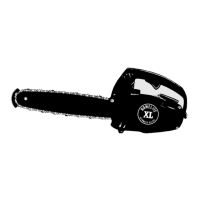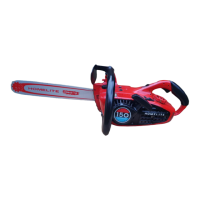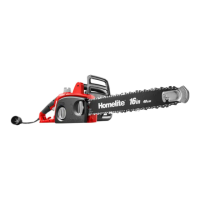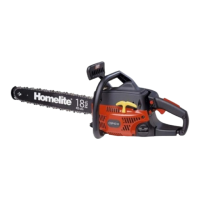FILING OUT "SKID-NOSE"
WEAR PATTERN
EDGED CUTTER BITES
OOD.
"SKID-NOSE" describes the edge area of teeth which
have hit hard objects such asstones, nails, etc., or cut dirt,
SKID-NOSE OF ABRADED CUTTER
sand, etc. The "skid-nose" rides the wood surface keeping
PREVENTS EDGE FROM CUTTING.
the sharp edges out of the wood. The friction at the "skid-
nose" area overheats the cutter steel, and the chain gets
"soft". The only way to restore the chain to good condition
is to file away all of the "skid-nose" steel. And, then
toad-
FILE AWAY ENTIRE SKID-NOSE
just all cutters to the same length. As this may be tedious
F TOOTH TO RESTORE.
to do by hand-filing, consider having it done by your servi-
cing dealer on an electric grinder.
REFILE ANY TEETH HAVING ONE OR MORE OF THESE FAULTS
1
Forward Hook
Chain will grab and jerk.
Producing rough-cutting.
Caused by excessive
downward filing pressure,
or tip of file held too
low on tooth.
Back Slope
Chain resists entering wood.
Scrapes instead of cutting.
Causes excessive heat and
wear to bar and chain. Caused
by lowering handle end of
file or holding file too
high on tooth.
Improper Top Plate
Angles
Blunt angle requires too
much feed pressure to cut.
Too sharp an angle causes
binding. Produces a rough
cut, robs power from saw,
and increases bar wear.
Caused by holding file at
wrong angle or letting it
drift or rock during the stroke.
Cutters Filed
at Non-Matching
Angles or Lengths
Chain will not cut at its
best. May cut off line or
"run" to one side. Drag will
slow down engine. Caused
by letting filing angle or pressure
vary from tooth to tooth, or
filing one side of chain
differently from the other.
Thin Feathered Edges
When they almost immediately
break off, you have a dull chain.
Usually found on chain filed
with a hook (see "Forward
Hook"). Caused by pressing
down too hard on file.
Blunt Cutting Edges
Although edge is durable, it
won't cut properly. Scrapes
wood, robs power, and pro-
duces dust instead of chips.
Caused by holding file too high
on face of tooth.
HOW AND WHEN TO SET DEPTH GAUGE CLEARANCE
AFTER FILING WlTH
JOINTER, GAUGE WILL
HAVE FLAT TOP
SO
...
Every second or third time the teeth are sharpened, or if a
large amount of steel is removed from the cutters, the
depth gauge should be checked for correct depth. Use a
USE A FLAT FILE
depth gauge tool and a flat file. Fit the tool over the chain
TO RECURVE THE FRONT
so that the slotted end points towards the bar nose and the
SMOOTHLY
depth gauge pr0jec.t~ up through the slot. File the depth
gauge flush with the top of the tool. File all gauges to this
height. If the gauges are too high, the chain teeth will not
get a good bite. If too low, the teeth will take too large a
bite, causing the chain to grab and jerk. If some gauges
DO NOT NICK DRIVE LINK
are higher than others, the chain will cut off line, favoring
WlTH THE FlLE
the side having the lowest gauges.

